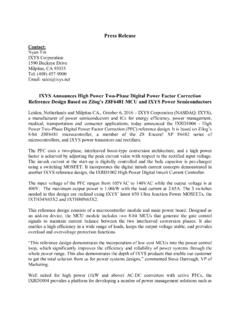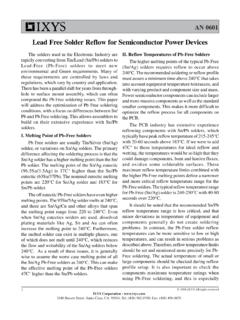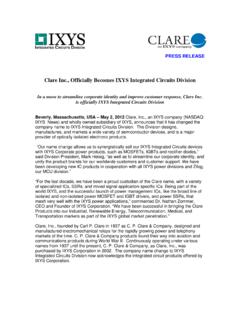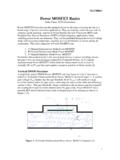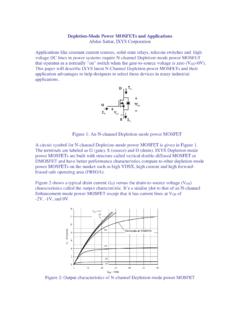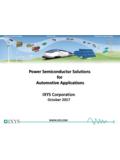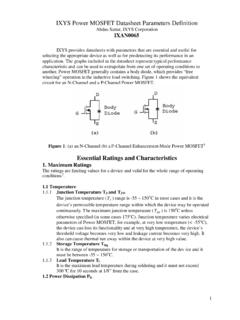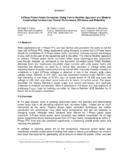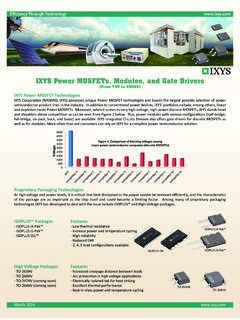Transcription of Driving your MOSFET or IGBT wild to ... - IXYS …
1 Driving Your MOSFETs Wild to Obtain greater efficiencies , power densities , and Lower Overall Costs. Sam S. Ochi Director of Integrated Circuits Research and Development ixys Corporation 3540 Bassett St., Santa Clara California USA Phone: 408-982-4355, Fax: 408-496-0670 E-mail: Abstract Gate driver selection guidelines and rules for Driving Standard, Q-Class and F-Class MOSFETs are presented. A summary of key gate driver application issues and recommended use rules are given. A series of tables providing the recommended gate driver type, gate resistor value, and recommended application output power are provided for f (PWM) switching frequencies from 100 KHz to 4 MHz. I. INTRODUCTION power supply and system designers are constantly being pressed for greater efficiencies , greater power densities , and lower overall cost per Watt. Of particular interest are two families of low gate charge, Qg (on), MOSFETs available from ixys specifically developed to reduce both switching speed and switching losses, the Q-Class and the F-Class.
2 The Q-Class and the F-Class MOSFETs improve upon the standard MOSFET Qg (on) with a proprietary technique, which reduces the gate to drain feedback capacitance, Crss. The F-Class MOSFETs make further improvements upon this with parameters optimized for soft and resonant switching applications. ixys now offers a full selection of single and dual gate drivers to efficiently drive the Q-Class and F-Class MOSFETs as well as a wide selection of standard MOSFETs. Table 1 gives a summary of the new gate drivers available from ixys . Included are the three gate driver selection tables, Table 2 for standard MOSFETs, Table 3 for Q-Class MOSFETs, and Table 4 for F-Class MOSFETs. A more expanded set of selection tables which take into account all of the MOSFET voltage and current ratings as well as IGBTs, IGBT modules, and MOSFET modules will be provided soon at II. CIRCUIT APPLICATION ASSUMPTIONS The gate driver selection tables, Table 2 through Table 4, take into account the MOSFET type, its operating voltage, its rated drain current, its PWM switching frequency, and its recommended SMPS output power rating.
3 The Table 2 and Table 3 for the standard MOSFETs and the Q-Class MOSFETs respectively assume hard switching SMPS applications with total tr and tf limited to no more than 2% of the PWM period. Table 4 for the F-Class MOSFETs assume resonant mode - soft switching applications with total tr and tf at 10% of the PWM period. All three tables provide the recommended gate driver and sochi Page 1 10/22/02 IXAN0011 the recommended maximum value of the external gate resistor. The gate resistor values are chosen as a maximum allowable value for maintaining stability and minimizing spurious switching noise generation, and still keep within their respective tr and tf limits. The three tables also provide a computed total gate drive circuit power dissipation for a first order snapshot of the expected efficiency in relation to the recommended SMPS power output column contained in the tables.
4 It is assumed in discussions to follow that the gate Driving circuit is a lossy system, where the gate driver, the gate resistor, and any internal gate resistance of the driven MOSFET dissipates energy. The author has taken liberty to use a somewhat arbitrary set of rules of thumb in the discussion of allowable tr and tf times with respect to the total switching period for hard or non-resonant switched systems at 1% of the total PWM period, and for soft or resonant switched systems at 10% for the total cycle PWM period. It is believed that times less than tr and tf recommended in these two different instances increases the difficulty in containing or controlling switched EMI or electrical noise, and switching times greater than those recommended tend to reduce the overall efficiency or energy savings of the SMPS system. III. ixys GATE DRIVERS Table 1 provides a snapshot of the new IC gate drivers produced by ixys and referred to in this article.
5 There are other gate drivers not presented here with features and functions not available from those in Table 1 that ixys has developed and is developing, so please visit our web site at for the latest information. There are alternate sources to some of the gate drivers presented in Table 1 so if interested, please contact ixys for alternate source manufacturers. The gate drivers in Table 1 are segregated by their output current capability. sochi Page 2 10/22/02 IXAN0011 New Gate Driver Family From ixys Gate Driver Part # Product Family Description Output Current Packages Available Package Codes IXDD402 Dx402 Dual, Noninv with EN2 x 2 Amp PI, SI, SI-16 PI -- 8 Pin Dip IXDF402 Dx402 Dual, Noninv & Inv 2 x 2 Amp PI, SI, SI-16 SI SO8 or SO14 IXDI402 Dx402 Dual Inv 2 x 2 Amp PI, SI, SI-16 SI-16--SO16 IXDN402 Dx402 Dual Noninv 2 x 2 Amp PI, SI, SI-16 CI--TO220 IXDD404 Dx404 Dual, Noninv with EN2 x 4 Amp PI, SI, SI-16 YI--TO262 IXDF404 Dx404 Dual.
6 Noninv & Inv 2 x 4 Amp PI, SI, SI-16 IXDI404 Dx404 Dual Inv 2 x 4 Amp PI, SI, SI-16 IXDN404 Dx404 Dual Noninv 2 x 4 Amp PI, SI, SI-16 IXDD408 DD408 Noninv with EN 8 Amp PI, SI, CI, YI IXDD409 Dx409 Noninv with EN 9 Amp PI, SI, CI, YI IXDI409 Dx409 Inverting 9 Amp PI, SI, CI, YI IXDN409 Dx409 Noninverting 9 Amp PI, SI, CI, YI IXDD414 Dx414 Noninv with EN 14 Amp PI, SI, CI, YI IXDI414 Dx414 Inverting 14 Amp PI, SI, CI, YI IXDN414 Dx414 Noninverting 14 Amp PI, SI, CI, YI Table 1 In applying of all of the gate drivers from ixys and those available from other vendors, here are some universal rules: 1. The gate driver power pins, VCC and GND, need to be bypassed by a low Electrical Series Resistance, ESR, and a low ESL, Electrical Series Inductance, capacitor. An example of such a capacitor is a high quality surface mountable monolithic ceramic bypass capacitor. 2. This bypass capacitor must be placed physically as close to the gate driver as possible, within 3mm ( ) or so.
7 The best physical placement of the bypass capacitor is to let it straddle the VCC and GND pins on the other side, (the solder side as opposed to the component side) of the driver VCC and GND power pads. 3. The value of this bypass capacitor must be at a minimum 50 times the value of the driven device input gate capacitance, CISS. 4. The gate resistor must be non-inductive, with carbon composition being the best, carbon film or metal film the second best, and the wirewound being the worst. It is not recommended that wirewound resistors be used as gate resistors. 5. The path of the area enclosed by the gate driver output, to the gate resistor, to the gate terminal of the driven device, with respect to the gate driver GND terminal to the source terminal of the driven device must be minimized. sochi Page 3 10/22/02 IXAN0011 Overall inductances of the gate driver output to the driven MOSFET as well as the driven MOSFET source to the driver GND must be minimized.
8 6. The total distance traversed from the gate driver to the driven MOSFET must be minimized, the shorter the better. III. Driving STANDARD MOSFETS The Table 2 provides a gate driver selection table for three different current ratings of standard ixys MOSFETs. The second column shows the gate charge, Qg (on), the third column the peak gate current, Ig, needed to swing the MOSFET gate from 0V to VCC =+15V and back to 0V within 1%, (tr= and tf= for a total of 1%) of the PWM frequency period, f (PWM)=100 KHz, or Ig=Qg (on)*(1/. 01)*f (PWM). The fourth column provides the recommended maximum value of external gate resistor, whose value is calculated as: Rg=2/3*VCC/Ig where VCC =15V. The fifth column is the total power dissipated in the gate Driving circuit, which is represented by Pg= Qg (on)* VCC * f (PWM). The sixth column is the recommended gate driver product family. The asterisk next to the driver signifies the driver must be heat sunk and must be either in the surface mountable TO262 or the through hole TO220 packages.
9 The data is repeated for f (PWM)=200 KHz and f (PWM)=400 KHz. The very last column shows the recommended power output rating of the SMPS system using the MOSFET given in the first column. It can be seen from Table 2 that in a typical half bridge SMPS output configuration where there is an upper and a lower MOSFET switch of similar size, and with the recommended power output rating of 500 Watts, approximately of the energy is lost in the gate drive system at 100 KHz, a negligible value for today s 95% efficient system. At 400 KHz, still only of the total energy output is predicted to be consumed by the gate drive system, or approximately 4% of the total energy budget for a ~95% efficient SMPS system. Driving Standard ixys MOSFETs fPWM = 100kHz fPWM = 200 KHz fPWM =400 KHz Standard Qg in Peak Ig in Rg in Total Pg Gate Peak Ig in Rgin Total Pg Gate Peak Ig in Rg in Total Pg Gate Rcmd Pwr MOSFET nC Amp Ohm W Drvr AmpOhmW Drvr AmpOhmW Drvr Out IXFH6N100 88 Dx404 500 WIXFH12N100 122 DD408 1KW IXTK21N100 250 Dx414* 2KW sochi Page 4 10/22/02
10 IXAN0011 Table 2 IV. Driving Q-CLASS MOSFETS The Q-Class series of MOSFETs are optimized for low gate charge, Qg (on), to reduce gate drive energy loss. Table 3 provides the gate driver selection table for the Q-Class MOSFETs whose current and voltage ratings were selected to be similar to the ones in Table 2 for comparison purposes. The most straightforward way of improving the efficiency of an existing SMPS system design is to simply replace the standard MOSFET used with an equivalent Q series MOSFET of the same Rds (on) and voltage rating, --- a no brainer! An examination of the two tables, Table 2 and Table 3 at f (PWM)=400 KHz shows that the total energy lost in the gate drive system, Pg, has been reduced by 50% to 80%. Driving Q-Class MOSFETs fPWM = 200 KHz fPWM = 400 KHz fPWM = 800 KHz Q-Class Qg in Peak Ig in Rg in Total Pg Gate Peak Ig in Rgin Total Pg Gate Peak Ig in Rg in Total Pg Gate Rcmd Pwr MOSFET nC Amp Ohm W Drvr AmpOhmW Drvr AmpOhmW Drvr Out IXFH6N100Q 48 Dx404 500 WIXFH12N100Q 90 Dx409* 1KW IXFH21N100Q 170 Dx408* Dx409* Dx414* 2KW Table 3 It is my belief that non-resonant hard switching techniques not be used for f (PWM) much above 1 MHz.
